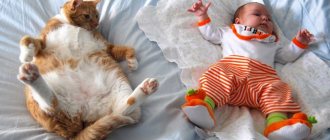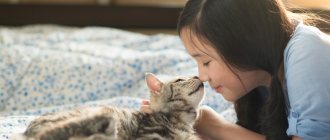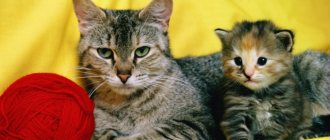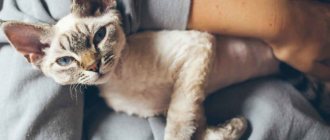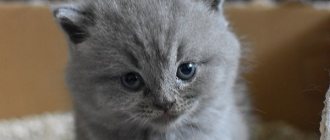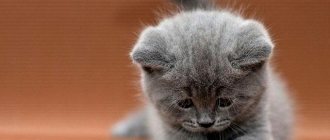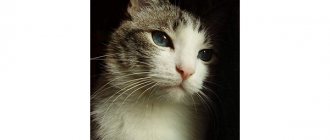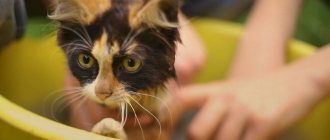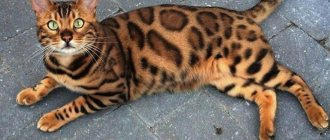The animal's postures and gestures, such as the tongue of a cat's tail, are in most cases well understood by hobbyists. Those owners who have just started communicating should learn what this or that movement means. A cat expresses its emotions in ways accessible to it: with its head, ears, paws, tail, meowing, tongue, characteristic sounds, a combination of gestures and behavior. Sometimes special attention is required so as not to miss a signal about the disease.
Expressive cat tail gestures
A cat's tail is one of the most expressive parts of the body. With its help, she can talk about a variety of emotions and feelings. The tail can:
- move from side to side;
- twitch and tremble;
- rise vertically;
- squeeze between paws.
Active wagging of the tail indicates that the pet is irritated and excited. If at the same time the hairs on it stand on end, the tail becomes fluffy, it is advisable to leave the pet alone so as not to provoke aggression or even an attack. The tail can move horizontally and vertically.
When a cat is interested in some object, it focuses all its attention on it, the tip of its tail begins to twitch. But such a gesture can also appear during aggression. For example, it is observed when a stranger invades territory that the cat considers its own. Tail quivering also has two meanings. This movement appears when the cat leaves marks in its area. If the tail trembles when the cat is scratched, stroked, or rubs against the owners’ legs, this is a sign of affection and love.
When the pet feels a surge of happiness, he feels confident in his own importance, then the tail rises vertically. He develops an appropriately important gait and other confirming gestures. When danger appears, if the cat is afraid, it lowers its tail and places it between its hind legs. Such a gesture may also indicate that the pet feels lonely, abandoned, and unhappy.
Why do cats fluff their tails?
If the cat has taken a pose with an arched back and a fluffed tail, this is a sure sign of fear for its life. At this moment you need to try to calm her down and remove all possible irritants. You can feed her or play with her to cheer her up.
Tail pressed to the ground
A cat may lower its tail if it is scared or anxious or in pain. We need to try to improve her mood and make things easier.
"Talking" movements of the ears and head
A cat can “tell” a lot of interesting things with its ears, head and whiskers. She can:
- prick or press ears;
- lower, raise your head;
- point the mustache forward and backward.
These animals do not need to move their heads to hear everything that is happening to the side or behind. To do this, they only need to turn their ears in the direction of the sounds. If the ears perk up, it means the cat is very interested in something and is studying the object. When the animal senses approaching danger, the ears are pressed to the head, the tips pointing back. This way the pet protects its ears.
A cat that feels a surge of happiness and trusts its owner walks with its head held high. At the same time, her ears are pricked up, as if she wants to hear praise, compliments addressed to her, to make sure that she is really loved. Raising your head up can be a gesture demonstrating a dominant position. You can also observe a situation when a cat is driven “into a corner” and needs to defend itself. The ears are pressed down.
In a calm environment, a lowered head may indicate a feeling of peace, boredom or drowsiness. Sometimes a cat lowers its head as a sign of humility, submission, if it is attacked by another cat with which it cannot cope.
By the direction of the whiskers you can determine your pet's mood and emotions. If they are pulled back, the animal intends to attack or defend itself. A mustache pointing forward indicates a relaxed, calm state and pleasant emotions.
How to understand a cat?
Tail movements
Every experienced lover of these animals understands the language of cats perfectly. But some nuances of behavior, gestures, and what they mean are unknown even to them. It is believed that if a cat beats its tail, it is angry. In reality, his position means many things. The position perpendicular to the top is interpreted differently, depending on the nuances:
- Fluttering along the entire length or the end is relaxed is a gesture of satisfaction with the state of things.
- Raises it up sharply - greets the owner or a friendly individual of its own species.
- The tip is bent - the cat demonstrates dominance over the territory.
- The fur is tousled - meaning: an aggressive attitude or one of the poses of superiority.
If cats lower their tails, then the gestures mean something else. A disheveled organ indicates confusion; the animal is not in control of the situation. If a cat tucks its tail, and even fixes it between its hind legs, then it needs encouragement and help, it is very afraid. This position can be seen when a newly brought kitten is introduced to other pets, such as dogs or adults. Lightly playing with the tip in a lying position means relaxation and curiosity. Sudden movements of the entire organ from side to side - readiness to attack or imitation of aggression in games.
A cat's tail is designed for thermoregulation. Therefore, animals native to hot countries have an increased organ length.
Head position
If a pet wants to play and communicate with the owner, it nods its head and stretches it out.
A cat's tail held high at the same time as a welcoming purr means greeting. At the same time, the animal slowly nods its head, and if it also extends it, it wants to communicate. The downward position should alert you - aversion to the outside world, a desire to rest, indifference. Drooping whiskers often indicate poor health of the animal and even serious illness. A visit to the veterinary clinic is required.
Flatten ears
The mobility of this organ gives the domestic cat the opportunity to inform the outside world about many things. Ears to head - aggression, fear. If the cat’s tail is also lashing from side to side, then the pet is about to attack. Similar gestures can be seen when a mouse is detected and ready to hunt. Turns in different directions, twitching - assessment of the situation, interest, curiosity. You should pay attention when the cat has its ears flattened and there is no playful, hunting or dangerous situation. She has clearly done some mischief somewhere, she understands this and is afraid of punishment.
Eyes and pupils
If you place a domestic cat on a chair near the owner, then it will express its pleasure, even bliss, with a quiet purr, a slow movement of the tip of its tail and half-closed eyelids, under which you can see constricted pupils. If the animal is frightened, it will jump up sharply, while its eyes will widen and its ears will press to its head. This behavior is a demonstration of fear and readiness to defend.
Voice for communication
When an animal is in an aggressive mood or does not want to be touched, the pet snorts and hisses.
Talkative cats can be found, but not often. They usually use meowing to get attention when they want to go outside, for example, and need the door opened. Upon returning from a walk, they may greet you with a cursory “meow-meow.” If the cat sits near his food bowl and makes vocal signals, this means that he is hungry and requires food. When the owner addresses the cat directly, and she understands this, she can respond with a kind of purr, sometimes purring. “Clicking” with your tongue and teeth during an unsuccessful hunt is an extreme nuisance. Snorting is a warning of a possible, but not certain, attack. A howl is fear, horror, a signal of a forced attack for the purpose of defense.
Other gestures
Poses and movements can be eloquent:
- If the animal is unhappy and raises its forelimb, this means it is ready to strike. Aggression can also be directed at the owner if he hits the animal or shouts at it.
- Demonstratively licking oneself with one's back to the owner is an insult.
- The tip of the tongue sticking out is pleasure.
- Sleeping on your back with your paws up is a feeling of complete security.
- A light massage with the owner’s claws is gratitude, the highest degree of bliss.
Cat's eye language
In communication between people, views play a fundamental role. Cats can also “tell” a lot with their eyes. There are several options in cat language:
- wide open eyes, gaze;
- squinted eyes;
- slow blinking.
If the cat's eyes are wide open, this is a gesture that should frighten the enemy. The pet uses such a “weapon” if there is a fight with another cat, or if he is going to attack a person or another animal. A pet can open its eyes wide when it is interested in something and carefully studies the object.
When a feeling of complete trust appears, cats close their eyes. She is not afraid of anything, she is impressed by the person or animal nearby. Slow blinking also indicates pleasant emotions; it can be observed when a cat purrs.
Lovers of these pets know that if there are several people in the room, there is a high probability that the cat will approach someone who is unkind to animals. The fact is that direct gaze is perceived as a threat. People who love cats will certainly look at the pet. And a person who has a negative attitude towards these animals looks away. The cat believes that he is the safe object.
What should you be wary of?
You can’t beat a cat even as a joke - it will remember, be offended and take revenge.
An animal can clearly signal its condition. It should especially frighten the owner when the cat sits for a long time with its forehead pressed against the wall. She cannot say that she has a severe headache, and she vitally needs the help of a veterinarian. When animals poke their noses into your hands, it is a request for help. Intermittent breathing with an open mouth - fatigue from extreme heat, a way to cool down and relax. The whitish membrane of the eye is visible - you need to leave your pet alone and let him sleep.
Fracture or dislocation
The cat's tail is part of the spine. It consists of bones, so sometimes dislocations and even fractures of this part of the body occur. This happens, for example, if an animal falls from a height or gets its tail pinched by a door.
Watch your pet carefully. If he does not sit down completely, but holds his tail between his paws, this means that the animal is experiencing pain. Damage to the spine is fraught with serious irreversible consequences, because the spinal cord also suffers. Therefore, immediately take the injured four-legged animal to the veterinarian for examination. Only a specialist will be able to establish an accurate diagnosis using x-rays and prescribe the necessary treatment in a timely manner. You won't be able to help your pet on your own.
The influence of cat age and breed on tail length
The length is measured from the sacrum to the extreme point of the last vertebra. In long-tailed cats it ranges from 20–28 cm to 40 cm, which depends on the individual characteristics of the cat and its breed. For example, Persians have a shorter average length than Oriental cats, while Maine Coons have a longer tail than both.
How does a cat's age affect tail length?
The length also depends on the age of the animal, because kittens have the same number of vertebrae in their tail as adults. However, during growth, the width and length of the caudal vertebrae increase, so it becomes longer.
Severe stress
A cat's tail between its legs indicates that there is some kind of problem. Sometimes it is not physical, but psychological in nature. Pets are susceptible to emotions, just like people. Pets have a hard time being separated from their owner, visiting a doctor, moving to a new place of residence, and other similar events.
If an animal is afraid or has experienced severe stress, then such problems often manifest themselves with just such a symptom. When a domestic cat suddenly gets outside for the first time, she will behave this way. In this way, she tries to protect the abdominal area and vital organs. Try to show your frightened pet your love and care so that he can more easily overcome the shock.
Communication by smells
At first glance, it may seem that we are talking about marking territorial boundaries. But this is not entirely true, because there is also a secret type of communication between a pet and its owner using smells.
The most important aromas with which a cat establishes contact with its owner are the elusive odors left by the animal on a person with the help of specific glands located on the chin, forehead and lips.
These glands produce special odors used for greeting (a cat pokes its face after a long absence of its beloved owner). Cats often rub against the owner’s legs, leaving as much odor as possible on the owner’s clothes, and they also rub their muzzle into the person’s face and hands in order to leave more odor on the skin.
After such secret manipulations, a person receives a whole spectrum of specific odors that accompanies him everywhere. Cats believe that the owner also marked them when he stroked their fur or head, leaving their scent in return as a sign of devotion and love.
Communication using limbs
If a pet gently moves its furry paws and at the same time releases its claws, then the animal is content and in a state of complete peace. Being in a good mood and feeling bliss, cats begin to mentally return to their early years. As a small kitten, the animal sucked its mother's milk and kneaded her belly with its paws. In addition to moving its paws, the cat begins to purr gently and soothingly.
Note! In such moments of bliss, the cat can forget itself and begin to release its claws, digging into the owner’s body. It is not recommended to scold or sharply pull your pet, as this can greatly offend an impressionable animal. It is best to carefully move the cat and pet it.
Very often, cats show their love for their owner by gently hugging them with their paws. But if the paw is raised sharply upward, with its claws extended, it means that the cat is preparing to defend itself and is determined.
Problem with nerve endings
During the period of active growth, cats sometimes experience disturbances in the development of the spine. This leads to pinched nerve endings and increased muscle tone. Then the animal cannot fully control its tail, and is not even able to lift it.
It happens that disorders affect the entire musculoskeletal system. Such pets experience underdevelopment of the chest or curvature of the paws. A nerve rupture may also occur due to injury: for example, a strong blow to the back.
